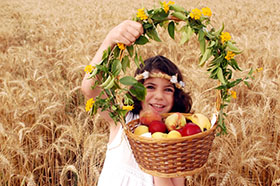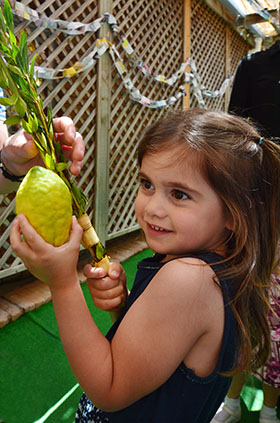There are three Jewish festivals referred to as the ‘Pilgrim Festivals’. Each festival of these three reflects an agricultural theme connected to the produce of the land of Israel. They are called ‘pilgrim’ festivals because in ancient times, when the Temple still stood in Jerusalem, Jews would make pilgrimage to the Temple in order to pray there on each of these festivals.
The three Pilgrim Festivals are Pesach (Passover), Shavuot and Sukkot. In Hebrew, they are referred to as Shalosh HaRegalim.
 Pesach (Passover)
Pesach (Passover)
This festival originally marked the early harvesting of the barley, commemorated by the special offering of the Omer on the second day. The term ‘Pesach’ means ‘to pass over’ and commemorates the release of the Jewish people from bondage in the land of Egypt. Pesach is observed for eight days (but only seven in Israel), commencing on the 15th Nissan. The four days in the middle are referred to as Chol Hamoed (‘weekdays of the festival’).
Different Names for Pesach:
Pesach
This festival originally marked the early harvesting of the barley, commemorated by the special offering of the Omer on the second day. The term ‘Pesach’ means ‘to pass over’ and commemorates the release of the Jewish people from bondage in the land of Egypt. Pesach is observed for eight days, (seven in Israel), commencing on the 15th Nissan. The four days in the middle are referred to as Chol Hamoed (‘weekdays of the festival’).
Chag haMatzot
Literally, ‘the festival of matzot’ (unleavened bread). During Pesach it is a mitzvah (commandment) to eat matzah as the Torah states “Seven days you shall eat unleavened bread” (Exodus 12:15).
Z’man Cherutenu
Literally, ‘time of our freedom’. Egypt is referred to in the Torah as Mitzrayim or ‘place of narrowness’. A place of narrowness is a wonderful symbolic image for the restrictiveness of slavery. Through the Pesach story, we travel from the narrowness of forced servitude to the openness of freedom.
Chag haAviv
Literally, ‘festival of spring’. In the land of Israel Pesach falls in springtime. It is spring harvest time. Almost the entire world is emerging from the restrictions of winter and opening up to the new life of spring. The Exodus narrative mirrors this journey.
For more detail, see our Pesach page.
 Shavuot
Shavuot
The second of the three Pilgrim Festivals is celebrated for 2 days outside Israel (and in Israel for 1 day). The name Shavuot means ‘weeks’ because it occurs 7 weeks after the 2nd day of Pesach. It falls on the 6th day of Sivan. The Torah was given to the Jewish people on Shavout.
This festival marked the harvest of the wheat crop, the last grain harvest of the season, and the beginning of the fruit harvest. A major feature of the celebration was the ceremony of bringing the “first fruits”, or Bikkurim, of the harvest to the Temple as an offering of thanks.
The Bikkurim were carried in beautifully decorated baskets. Families would gather together to walk to Jerusalem and they would sing, dance and have music playing whilst they walked. When they arrived at the Temple, they gave the bread and fruit to the priests who would bless them. Today synagogues are decorated with greenery and flowers at Shavuot.
Tradition has it that King David was born and died on Shavuot and many students in Jewish schools have their graduation on Shavuot.
Different Names for Shavuot
Z’man Matan Toratenu – the Time of the Giving of Our Torah
Chag haBikkurim – Festival of the First Fruits
Chag haKatzir – Harvest Festival
Chag Matan Torah – Festival of the Giving of the Torah
For more information, see our Shavuot page
 Sukkot
Sukkot
Originally a harvest festival, Sukkot was given added historical significance as a commemoration of the exodus from Egypt, when the Jewish people had to live in temporary dwellings whilst they lived in the desert before entering the Promised Land.
Different Names for Sukkot
Chag haAsif – the Festival of Gathering. After our ancestors had gathered in the land of Canaan, they realised that Sukkot was celebrated in Autumn, a time when they gathered the crops. The crops from the fields and the fruits of the orchards had been gathered. These events were celebrated with great excitement. Sukkot is also referred to as Z’man Simchatenu (‘The Time of Our Happiness’).
The Four Species
There are four kinds of plants known in Hebrew as the Arbah Minim (‘Four Species‘). These are said to represent the unity of Israel (amongst other things). They are:
Aravot – willows that have neither fruit nor fragrance
Lulav – palm branch that has no fragrance, but has fruit which can be eaten
Etrog – citron, similar to a lemon, that has a sweet fragrance and can be eaten
Hadassim – myrtles, that have a pleasant fragrance but cannot be eaten
The three myrtle twigs and the two willows are tied together to the palm branch and together the entire bouquet is called the lulav.
The four species were intended to symbolise the final harvest and the fertility of the land.
For more information, see our Sukkot page
Related Page
Chol HaMo’ed (intermediate days of a festival)


